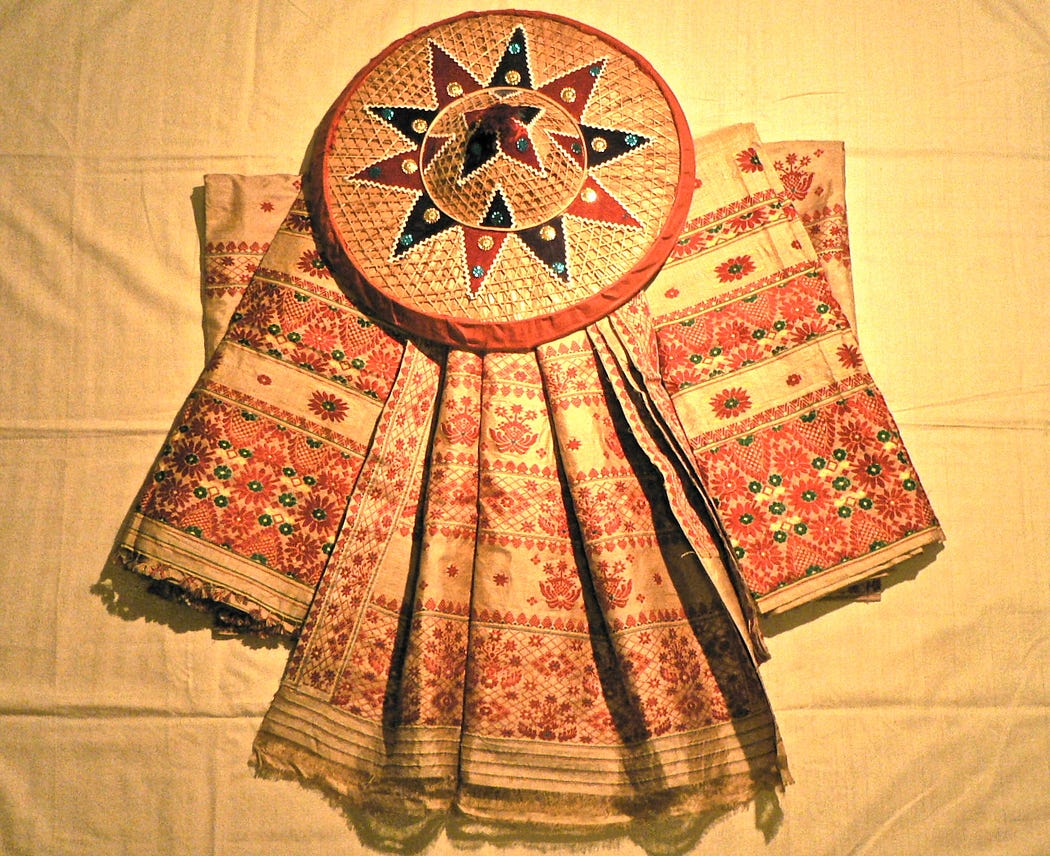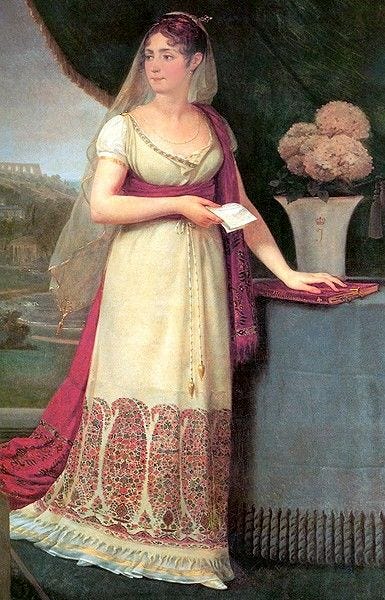
Introduction
As we celebrate National Handloom Day today (August 7, 2025), we also celebrate the vibrant legacy of India’s handloom industry, a living tapestry of culture, craftsmanship, and creativity that has adorned our nation for centuries. As a Madhubani artist, my journey with art extends beyond the intricate motifs of Mithila paintings to the delicate threads of India’s handwoven textiles, such as Chanderi, Tussar, Kerala Kasavu, and Maheshwari.
Each fabric tells a story of people, of traditions, of their connection to the land. Through my wearable art, I seek to bring Madhubani’s narrative strength to the loom, blending it with the heritage of handweaving. This article is both a tribute and a call a celebration of India’s diverse handloom traditions and a reminder of our collective responsibility to preserve them.
A Tapestry of Tradition: India’s Handloom Fabrics by Region
India’s handloom heritage reflects the depth of its cultural geography. Here’s a curated selection of traditional handloom fabrics — each a regional marvel, rooted in legacy and technique:
Khadi (Pan-India, esp. Gujarat)
A symbol of India’s freedom struggle, Khadi is hand-spun and handwoven from cotton, silk, or wool. Its coarse texture and breathability make it ideal for warm climates, while its philosophy of self-reliance and sustainability continues to inspire modern designers.
Jamdani (West Bengal)
A fine muslin weave once patronized by Mughal emperors, Jamdani features ethereal floral and geometric motifs woven directly into the fabric. Each piece can take weeks to months to complete, testifying to the weaver’s patience and artistry.

Banarasi Silk (Uttar Pradesh)
Woven in Varanasi, Banarasi silk sarees are known for their opulent zari work, rich textures, and Mughal-inspired patterns. Traditionally worn for weddings and special occasions, they are prized family heirlooms.
Patola (Gujarat)
Among the most intricate double-ikat weaves in the world, Patola textiles are dyed before weaving, resulting in symmetrical, vibrant, geometric patterns. Woven mostly in Patan, they are considered sacred and luxurious. Gujarat is known for its world famous double ikat patola from patan. It is a colourful and ostentatious weave with its figured body, along with the subtle merging of one shade into another. It is generally worn on auspicious and important occasions. The magic of patola textile is created by the art of lying and dyeing both the warp and west silk threads and then weaving them with great skill and precision into priceless fabric forms with clear and crisp patterns. The raw material used for weaving is cultivated silk single ikat patola is also woven in some villages of surendranagar and Rajkot district in which only weft in separately: ie-dyed before weaving to create patterns. The patterns through similar are simpler than the intricate one and are more economical than those of patan.

Maheshwari (Madhya Pradesh)
A blend of cotton and silk, Maheshwari fabric is lightweight with graceful stripes, checks, and floral borders. Originally created for royal use, today it lends itself beautifully to both sarees and dupattas with Madhubani art.

Ikat (Odisha, Telangana, Gujarat)
This resist-dyeing technique involves dyeing the yarns before weaving, creating blurred, feathery edges in the final patterns. Known for vibrant geometric designs, Ikat is used in everything from sarees to home décor.

Orissa Ikat
“Orissa Ikat” is a kind of Ikat known as Bandhakala and Bandha, a traditional dyeing technique, originating from Indian State of Odisha. It is generally known as ’Bandhakala’, ‘Bandha’, ‘Bandha of Odisha’. It is a geographically tagged product of Odisha. It is made through a process of tying and dyeing the warp and weft threads to create the design on the yarn prior to weaving. Orissa Ikat is not confined to geometrical design, rather fine, sharp artistic curvilinear designs in the form of Lahari, Lata (creeper), Ghagra, Deuli (temple) etc. are its special characteristics. (GI Application No.-22/Certificate Date: 07/06/2006
Paithani (Maharashtra):
A regal silk weave from Paithan, adorned with gold and silver threads, Paithani features motifs like peacocks, lotuses, and vines. The vibrant palette and gleaming zari make it a bridal favorite.

Kanchipuram (Tamil Nadu)
Kanjeevaram silks are renowned for their density, vivid hues, and temple border motifs. The silk is sourced from Karnataka, zari from Gujarat, and the weaving technique from centuries of South Indian tradition.

Bagh (Madhya Pradesh):
A block-printing craft using natural dyes, Bagh prints are inspired by flora, fauna, and jali designs from Mughal architecture. The distinctive red and black palette lends it a rustic charm.

Ajrak (Gujarat, Sindh — cross-border heritage):
Traditionally worn by pastoral communities, Ajrak uses natural dyes and wooden blocks to create symmetric, geometric, and floral motifs. The deep indigo and madder tones are iconic.
Bandhani (Gujarat, Rajasthan)
This tie-dye technique creates tiny dot or wave patterns by plucking and tying parts of the cloth before dyeing. Bandhani is festive, joyful, and deeply embedded in cultural rituals.

Chanderi (Madhya Pradesh)
Known for its sheer texture and glossy finish, Chanderi fabric is a silk-cotton blend often embellished with zari and fine motifs. As a Madhubani artist, I often use Chanderi as a luminous canvas for my paintings.
Kota Doria (Rajasthan)
A blend of cotton and silk, woven with square-like patterns called ‘khat’, Kota Doria is airy and translucent. Ideal for hot climates, its gossamer quality gives it a royal allure.

Baluchari (West Bengal)
Woven from silk, Baluchari sarees feature narrative scenes from epics like the Ramayana and Mahabharata on the pallu. These storytelling weaves are like visual scriptures.

Bhagalpuri Tussar Silk (Bihar)
Harvested from wild silkworms, Bhagalpuri Tussar has a rich, earthy sheen and a slightly coarse texture. It’s one of my favorite surfaces to paint on, resonating with the rustic origins of Madhubani.

Phulkari (Punjab)
Meaning “flower work,” Phulkari uses vibrant silk threads embroidered on coarse cotton, often in dazzling geometric patterns. It’s a visual celebration of life, worn during weddings and festivals.

Muga Silk (Assam)
Exclusive to Assam, this golden-hued silk is prized for its natural sheen and durability. Muga garments last generations and are considered auspicious.

Ilkal (Karnataka):
Identified by its contrasting red pallu and temple borders, Ilkal sarees use a traditional tope teni technique to join the pallu and body seamlessly.

Kalamkari (Andhra Pradesh, Telangana):
These are hand-painted or block-printed fabrics with intricate mythological or nature-inspired stories. The term comes from “kalam” (pen) and “kari” (work), and it’s a favored pairing with Madhubani motifs.
Chikankari (Uttar Pradesh):
Originating in Lucknow, this is a delicate white-on-white embroidery done on muslin, silk, or chiffon, with floral and paisley motifs. It evokes subtle elegance.

Kullu Wool Shawls (Himachal Pradesh):
Handwoven in bright colors with geometric tribal patterns, these woolen shawls are both warm and bold in design.
Kashmiri Pashmina (Jammu & Kashmir):
Made from the fine undercoat of Changthangi goats, Pashmina is famed for its luxurious softness. Often hand-embroidered, each piece is a symbol of quiet opulence.

Gadwal (Telangana):
Known for a cotton body with a silk pallu and borders, Gadwal sarees are lightweight, comfortable, and intricately woven with motifs from nature and temple architecture.
Mangalagiri (Andhra Pradesh):
A mix of simplicity and elegance, these cotton and silk fabrics are known for their durability and minimal gold borders.
Nagaland Handloom (Nagaland):
These handwoven textiles are deeply tied to tribal identity, featuring bold geometric patterns in striking contrasts, often with symbolic meanings.
Lepcha Weave (Sikkim):
Traditionally woven by Lepcha women, these textiles have narrow stripes and are used to make traditional attire and accessories.

Sambalpuri Ikat (Odisha):
Featuring motifs like shells, flowers, wheels, and animals, this handwoven Ikat is prized for its durability and precision in design alignment.

Tangaliya (Gujarat):
A lesser-known weave where small bead-like dots are woven into the fabric using extra weft. Traditionally worn by pastoral communities. This 700-year-old weaving craft is native to the Dangashiya community of Surendranagar, Gujarat. The community consists of weavers and shepherds. The weavers make the blankets out of sheep and goat wool for the shepherds to wear. The threads are woven to create the signature style of the weaving technique which is the effect of raised dots on the fabric. Together, they create beautiful geometrical patterns. Today, these textiles are used to make dupattas, dress material, bedsheets and pillow covers.

Eri Silk (Assam, Meghalaya):
Known as the ‘Ahimsa Silk’, Eri is spun from open-ended cocoons without killing the silkworm. Its soft, woolly texture makes it suitable for both warm and cool climates.

Chettinad Cotton (Tamil Nadu):
Bright, bold hues and contrasting checks or stripes mark this handloom from the Chettinad region. The sturdy texture and vibrant palette make it unique.

Toda Embroidery (Tamil Nadu):
Created by the Toda tribal women in the Nilgiris, this black and red geometric embroidery on white cloth reflects their close relationship with nature.

Venkatagiri (Andhra Pradesh):
This silk and cotton weave is known for its fine count and silver zari. It balances traditional motifs with minimalistic charm.

Dharmavaram Silk (Andhra Pradesh):
Characterized by broad borders and rich color combinations, these silks are often used for bridal wear in South India.

Kerala Kasavu (Kerala):
Woven in pristine white or off-white cotton with rich gold zari borders, Kasavu sarees symbolize grace and are worn during festivals and weddings. I often paint on Kasavu, respecting its clean lines and understated elegance.

Conclusion
As a Madhubani artist, I find endless inspiration in these handloom traditions. Each fabric whether the gauzy shimmer of Chanderi, the rich depth of Tussar, the sacred elegance of Kerala Kasavu, or the regal finesse of Maheshwari — is not merely a textile but a canvas of culture.
On this National Handloom Day, let us celebrate more than just the beauty of these fabrics. Let us honor the hands behind the loom the weavers, dyers, spinners, and printers who keep this art alive. By wearing, gifting, and supporting handloom, we’re not just choosing slow fashion, we are choosing heritage, sustainability, and human connection.
Let the threads of tradition continue to weave our future.
Note: Part one of a two-part journey through the timeless handwoven textile heritage of India.
Source: Wikipedia, ClaudeAI, OpenAI, Ministry of Textiles, Gov of India, Textile and Handloom Corporations of Various states where the fabric originated
Originally Published on Medium
https://medium.com/@vidushini/rich-tapestry-celebrating-national-handloom-day-2025-through-the-lens-of-a-madhubani-artist-350d93f386c3

No comments:
Post a Comment